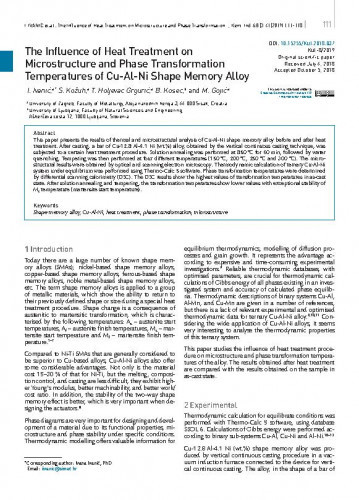This paper presents the results of thermal and microstructural analysis of Cu-Al-Ni shape memory alloy before and after heat treatment. After casting, a bar of Cu-12.8 Al-4.1 Ni (wt.%) alloy, obtained by the vertical continuous casting technique, was subjected to a certain heat treatment procedure. Solution annealing was performed at 850 °C for 60 min, followed by water quenching. Tempering was then performed at four different temperatures (150 °C, 200 °C, 250 °C and 300 °C). The microstructural results were obtained by optical and scanning electron microscopy. Thermodynamic calculation of ternary Cu-Al-Ni system under equilibrium was performed using Thermo-Calc 5 software. Phase transformation temperatures were determined by differential scanning calorimetry (DSC). The DSC results show the highest values of transformation temperatures in as-cast state. After solution annealing and tempering, the transformation temperatures show lower values with exceptional stability of Ms temperature (martensite start temperature).; U radu su prikazani rezultati toplinske i mikrostrukturne analize Cu-Al-Ni slitine s prisjetljivosti oblika prije i nakon toplinske obrade. Nakon lijevanja, šipka slitine Cu-12.8 Al-4.1 Ni (mas. %) dobivena tehnikom vertikalnog kontinuiranog lijevanja, podvrgnuta je određenom postupku toplinske obrade. Provedeno je homogenizacijsko žarenje pri 850 °C, zadržavanje na toj temperaturi 60 min i hlađenje u vodi. Nakon toga je provedeno popuštanje na četiri različite temperature (150 °C, 200 °C, 250 °C i 300 °C). Mikrostrukturna analiza provedena je optičkim i pretražnim elektronskim mikroskopom. Termodinamički proračun ravnotežnog ternarnog Cu-Al-Ni sustava proveden je pomoću Thermo-Calc 5 softvera. Temperature fazne transformacije određene su diferencijalnom pretražnom kalorimetrijom (DSC). Rezultati DSC-a pokazuju najveće vrijednosti temperatura fazne transformacije u lijevanom stanju. Nakon homogenizacijskog žarenja i popuštanja temperature fazne transformacije pokazuju niže vrijednosti s iznimnom stabilnošću Ms temperature (temperatura početka nastajanja martenzita).
Sažetak

 Kemija u industriji : 68,3-4(2019) / glavni i odgovorni urednik Nenad Bolf.
Kemija u industriji : 68,3-4(2019) / glavni i odgovorni urednik Nenad Bolf.